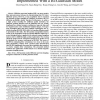Free Online Productivity Tools
i2Speak
i2Symbol
i2OCR
iTex2Img
iWeb2Print
iWeb2Shot
i2Type
iPdf2Split
iPdf2Merge
i2Bopomofo
i2Arabic
i2Style
i2Image
i2PDF
iLatex2Rtf
Sci2ools
TMI
2008
2008
Reduced Encoding Diffusion Spectrum Imaging Implemented With a Bi-Gaussian Model
Diffusion spectrum imaging (DSI) can map complex fiber microstructures in tissues by characterizing their 3-D water diffusion spectra. However, a long acquisition time is required for adequate -space sampling to completely reconstruct the 3-D diffusion probability density function. Furthermore, to achieve a high -value encoding for sufficient spatial resolution, the diffusion gradient duration and the diffusion time are usually lengthened on a clinical scanner, resulting in a long echo time and low signal-to-noise ratio of diffusion-weighted images. To bypass long acquisition times and strict gradient requirements, the reduced-encoding DSI (RE-DSI) with a bi-Gaussian diffusion model is presented in this study. The bi-Gaussian extrapolation kernel, based on the assumption of the bi-Gaussian diffusion signal curve across biological tissue, is applied to the reduced -space sampling data in order to fulfill the high -value requirement. The crossing phantom model and the manganese-enhanced ...
| Added | 15 Dec 2010 |
| Updated | 15 Dec 2010 |
| Type | Journal |
| Year | 2008 |
| Where | TMI |
| Authors | Chun-Hung Yeh, Kuan-Hung Cho, Hsuan-Cheng Lin, Jiun-Jie Wang, Ching-Po Lin |
Comments (0)

